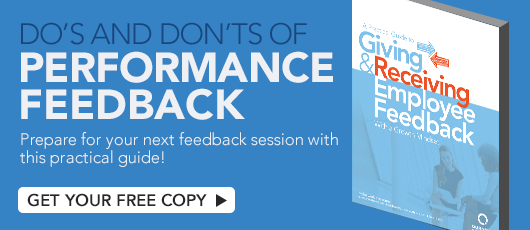Giving Great Feedback: What to Write in Employee Feedback
The way information is delivered can completely change the way it is received and interpreted. This is especially true when giving and receiving employee feedback. The wrong choice of words can offend, worry, and even disengage employees.
By using supportive, constructive, and direct language, people leaders and coworkers can encourage and acknowledge growth among each other. But this kind of language doesn’t come always come naturally.
Selecting the right words and phrases is imperative to getting the most out of feedback. Refer to this four-part glossary to ensure you're giving great feedback.
1. Be specific when describing the situation.
When giving employee feedback, it’s important to explain the situation you’re addressing. Be specific, so the other person understands the context. Mention the time and place or specific project task. Here are some example phrases:
- "At the board meeting last Tuesday morning…"
- "During our team meeting on Monday, when Jada was speaking…"
- "In the report you wrote on Friday about goal progress…"
- "When Xavier asked about our team’s metrics in the call on Thursday afternoon…"
- "At the client presentation you made last week…"
Being vague causes confusion for the other person because they don’t understand when you’ve witnessed the behavior. Providing specific context empowers the receiver to better repeat positive behaviors and address negative behaviors.
Using generalizations like "always" or "never" can raise the other person’s defenses (when feedback is corrective), as it is rare that someone does something 100 percent of the time. And in the case of positive feedback, the words "always" and "never" are still too general, and without reference of a specific situation, they can leave your colleague unsure about what exactly was good about his or her work.
2. Explicitly describe the behavior.
It’s important to only address the specific behaviors you witnessed. Try to use facts that can be measured to help ensure your comments are objective. Again, this is about providing context. Before giving advice or praise, explain what the person did or didn’t do that warrants the advice or praise. Try these phrases:
- "I noticed _______ when you _______."
- "When _______, you _______."
Here are some examples of how you can implement these phrases:
- "At the board meeting last Tuesday morning, you distributed the agenda well in advance, ensured the meeting started on time, took thorough notes, and made sure everyone received the synopsis in a timely manner following the meeting."
- "During our team meeting on Monday, when Jada was speaking, I noticed you were checking your phone and typing on your laptop."
- "In the report you wrote on Friday about goal progress, you missed 5 of the 10 corrections you were given to implement."
- "At the client presentation you made last week, you were well prepared, gave clear and concise answers to questions, respectfully challenged their thinking, and built a great rapport by providing examples and asking questions specific to their business."
- "When Xavier asked about our team’s metrics in the call on Thursday afternoon, you were unprepared and gave incorrect information."
Avoid adjectives and focus on actions. Rather than saying, "When Jada was speaking, I noticed you were distracted," focus on the actions: "You were checking your phone and typing on your laptop."
Adjectives can also make your feedback general. Saying, "You were not effective at leading the meeting," doesn’t provide employees with enough detail and it also inserts an evaluation of behavior rather than a statement of fact. Instead, you could say, "During the meeting, you didn’t follow the agenda and let the side conversations overtake the meeting."
3. Consider your "I" and "you" statements.
Use "I" statements, as opposed to "you" statements, to describe how the person’s behavior affected you or others. Continually using "you" puts you in an accusing and attacking position, throwing up the defenses of the receiver. Here are some phrases to try:
- "I felt _______ when you _______. "
- "I’m worried/happy that this _______ (describe the impact and who was impacted)."
Asking questions can be a helpful strategy when you might not have all the information surrounding a situation. Try these:
- "When you _______, why did you _______?"
- "When you _______, did you consider _______?"
4. Offer suggestions for improvement.
Finally, when making suggestions for improvement in feedback, understand they are suggestions not mandates. In the end, the other person is the one who has to commit to making the changes.
Use words and phrases that will help them self-reflect and that position them as the change agent. Here are some examples:
- "Consider _______ to improve _______."
- "You could try to _______ in the future."
- "When _______, try to _______."
Asking questions is a successful strategy to prompt self-reflection. Try using these:
- "Looking back at _______, is there anything you could have done differently?"
- "Could you _______?"
- "What if you _______?"
- "What would happen if _______?"
- "What would it be like if _______?"
- "What would need to happen to _______?"
- "What is the desired outcome?”
- "What is at stake?"
- "What are potential barriers, and how will you handle them?"
When giving advice, try to avoid these words:
- Should/need to: This implies that the feedback giver is all-knowing and that their suggestion is the only route forward. Opting for “could” or “consider” empowers the receiver to decide if they choose to implement the feedback.
- Just: This implies that your suggestion is always really easy or insignificant.
For more tips and tricks to nailing employee feedback, download our free ebook, A Practical Guide to Giving and Receiving Employee Feedback.







